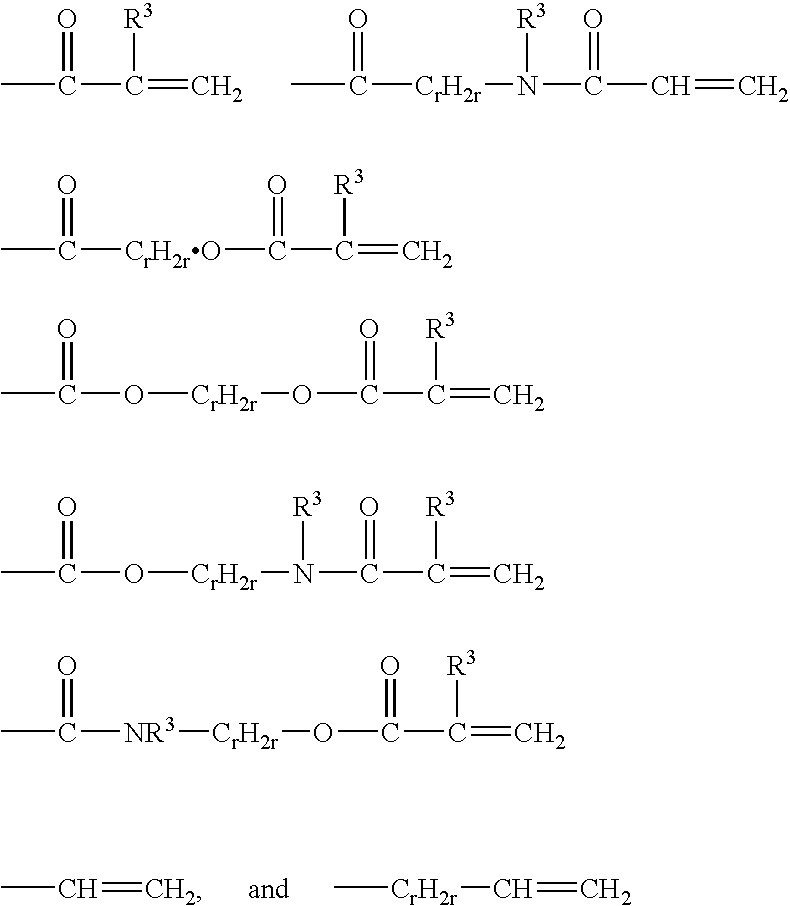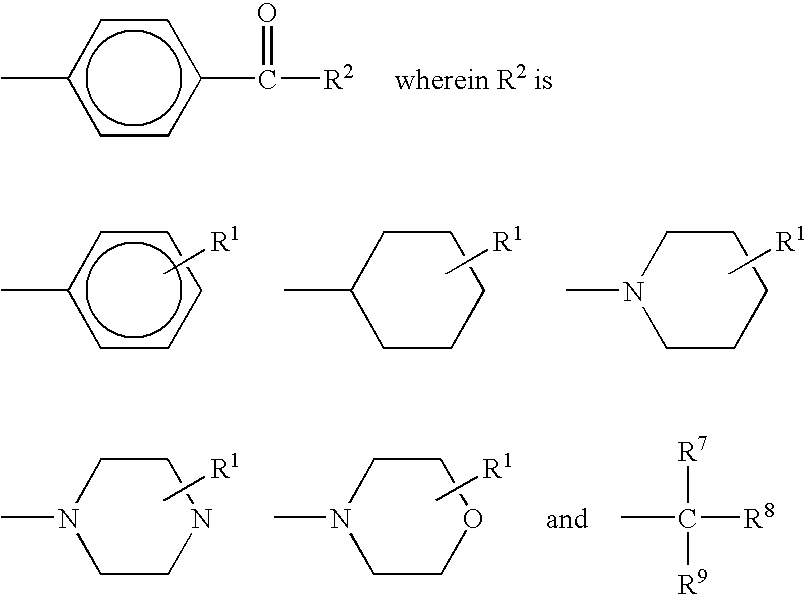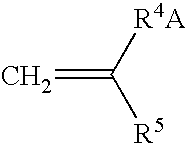Crosslinkable hydrophilic materials from reactive oligomers having pendent photoinitiator groups
a technology of reactive oligomers and hydrophilic materials, applied in the field of new materials, can solve the problems of insufficient absorption and cohesive strength balance, and achieve the effects of high performance materials, minimal shrinkage, and purity of materials
- Summary
- Abstract
- Description
- Claims
- Application Information
AI Technical Summary
Benefits of technology
Problems solved by technology
Method used
Image
Examples
examples
[0124] These examples are merely for illustrative purposes only and are not meant to be limiting on the scope of the appended claims. All parts, percentages, ratios, etc. in the examples and the rest of the specification are by weight, unless noted otherwise. Solvents and other reagents used were obtained from Aldrich Chemical Company; Milwaukee, Wis. unless otherwise noted.
Test Methods
Swelling (Uptake) Test
[0125] This test is to measure a polymer's ability to swell when placed in a saline solution. A jar was filled with approximately 200 milliliters of 0.9% saline solution. A 3 centimeter diameter disk, with an approximate thickness of 1.1 millimeters, of the polymer film of interest was weighed and the value was recorded as “dry weight”. The sample was completely submerged in the 0.9% saline and remained submerged for 24 hours. The sample was removed, allowed to drip for 1 minute, and then it was weighed and the value was recorded as “wet weight”. The percent uptake was calcul...
examples 1a-1f
Part I: Preparation of Photoinitiator Functional Oligomer
[0126] In a brown glass bottle, 65.04 grams (130 mmol) of MPEG, 34.95 grams (269 mmol) of HEMA, 1.001 grams (3.60 mmol) of PIA, 4.001 grams (33.9 mmol) of AMS, 0.400 grams (2.44 mmol) of AIBN and 100 milliliters of ethyl acetate were combined, sparged with nitrogen for 15 minutes and capped. The sealed glass bottle was shaken in a thermostated temperature bath shaker at 65° C. for 24 hours. The resulting oligomer had Mn=15,700 grams / mole and a polydispersity of 1.95 as determined by SEC.
Part II: Preparation of a Methacrylate Functional Oligomer
[0127] Various amounts of MAA-PEG were added to portions of the oligomer / ethyl acetate solution prepared in Part I above as shown in Table 1 to generate solutions A-G and were stirred at room temperature for 48 hours.
TABLE 1Example Solution% by Weight MAA-PEGA0.5B1.0C2.0D4.8E9.2F16.6G23.1
Part III: Preparation and Testing of Films
[0128] A portion of each oligomer solution A-G pre...
examples 2a-2d
Part I: Preparation of Photoinitiator functional Oligomer
[0129] In a brown glass bottle, 65.03 grams (130 mmol) of MPEG, 35.10 grams (270 mmol) of HEMA, 0.501 grams (1.80 mmol) of PIA, 4.07 grams (33.9 mmol) of AMS, 0.401 grams (2.44 mmol) of AIBN and 100 milliliters of ethyl acetate were combined, sparged with nitrogen for 15 minutes and capped. The sealed glass bottle was shaken in a thermostated temperature bath shaker at 65° C. for 24 hours.
Part II: Preparation of a Methacrylate Functional Oligomer
[0130] Various amounts of MAA-PEG were added to portions of the oligomer / ethyl acetate solution prepared in Part I above as shown in Table 3to generate solutions T-W and were stirred at room temperature for 48 hours.
TABLE 3Example Solution% by Weight MAA-PEGH0.5I1.0J2.0K4.8
Part III: Preparation and Testing of Films
[0131] A portion of each oligomer solution H-K prepared in Part II above was poured onto a Release Liner, dried in 40° C. oven for 16 hours and covered with another ...
PUM
| Property | Measurement | Unit |
|---|---|---|
| temperatures | aaaaa | aaaaa |
| coatable viscosity | aaaaa | aaaaa |
| shrinkage | aaaaa | aaaaa |
Abstract
Description
Claims
Application Information
 Login to View More
Login to View More - R&D
- Intellectual Property
- Life Sciences
- Materials
- Tech Scout
- Unparalleled Data Quality
- Higher Quality Content
- 60% Fewer Hallucinations
Browse by: Latest US Patents, China's latest patents, Technical Efficacy Thesaurus, Application Domain, Technology Topic, Popular Technical Reports.
© 2025 PatSnap. All rights reserved.Legal|Privacy policy|Modern Slavery Act Transparency Statement|Sitemap|About US| Contact US: help@patsnap.com



